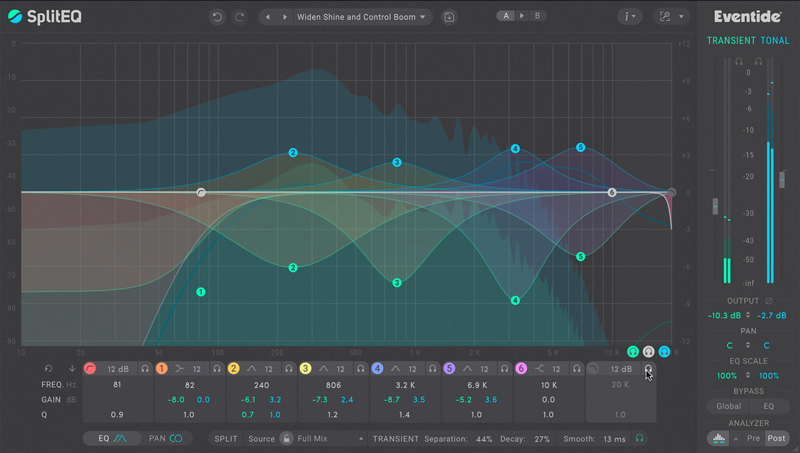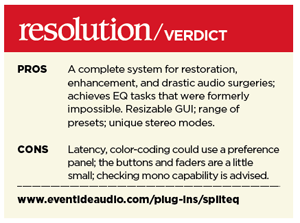

Music Connection Magazine Reviews Mix Magazine Reviews
Sign Up For A Free Trial Subscription To Resolution Magazine!
 |
| Eventide SplitEQ Plugin |
The Eventide SplitEQ™ (Mac and PC in VST, AAX and AU) is based on their patented Structural Split technology originally developed for an Eventide special effect plugin called Physion. Both Physion and now SplitEQ divides the incoming audio into two components or parallel streams: The fast-changing or 'transient' audio and more stable or 'tonal' signals, applies equalization separately to each, and then recombines them at the output.
For an equalizer/filter, this is a novel approach for applying corrective equalization and/or creative tone shaping for enhancing, repairing, or even widening the stereo image of audio sources including finished mixes.
The implications are many: now you can boost/cut (using extreme values) and focus on very specific and tight areas without the typical 'collateral damage' associated with drastic audio surgery using conventional equalizers.
Split And Display
The SplitEQ GUI has two faders/meters labeled Transient and Tonal for rebalancing these two components in any ratio. But the real power lies in the ability to do this microscopically in the frequency domain by individually cutting/boosting gain in the transient and/or the tonal streams and in up to eight overlapping frequency bands.
The resizable SplitEQ GUI displays the energies existing in both the transient and tonal components as two curves superimposed over an excellent real-time spectrum analyzer. You can view the summed tonal and transient signals together or split them into separate views and either pre or post processing using controls in the Structural Spilt section at the bottom of the GUI. (More below) The two curves (blue and green) are very close to the same color (visually, for me) and a good update would make these colors selectable preferences.
SplitEQ uses a beautiful-looking parametric EQ with high and low pass filters that have overlapping 10Hz to 20kHz ranges and up to 96dB/octave slopes. These two filters are fixed as shelves, but you can split them into transient and tonal streams and individually adjust the frequency point of their knees.
Six Bands
Next are six overlapping bands of precise filters with an extensive collection of controls available for each color-coded band in the Band Editor. The Band Editor has six filter types available for each of these six bands and, unlike the two shelving filters, each band's center frequency is the same for both transient and tonal streams; when you drag a node sideways in frequency, they move together. Filter types are: low shelf, peak, notch, high shelf, tilt shelf and bandpass. All EQ/filters in the six bands are available for individual adjustment for the transient and/or the tonal streams or you may adjust them locked together just like a conventional parametric EQ.
You can bypass individual EQ sections, link/unlink and solo tonal or transient EQ'd streams, apply different Qs from a broad .025 to an extremely narrow Q of 40, and set individual band gain(s) of either stream.
Stereo Audio
On stereo (only) audio tracks, clicking on the Pan button in the Split section changes the Band Editor into a Pan Editor so you may shuffle and spread the effect(s) of the transient and tonal EQs across the stereo field. Each band has a choice between regular L/R panning (intensity) or Mid/Side panning where the stereo width of the transient relative to the tonal is adjustable and you then preserve any offset between them; i.e. they move together when you make any subsequent changes. This is an amazing and evocative feature for me as a music mixer!
Structural Split Section
Besides selecting the EQ/Pan mode changes, this section might be your first stop when setting up SplitEQ by 'tuning' the algorithm to the source audio. The Split Source drop down menu has: Full Mix, individual acoustic drum kit drums and cymbals, Full drum kit, electronic drum kit, various percussion instruments, bass, piano/synths, guitar, vocal and, when all else fails, use Full Mix--the default.
SplitEQ includes a comprehensive library with over 150 presets in a drop down menu that will get you close and the A|B buttons allow quick auditioning of two settings with Undo/ Redo functionality.
The Split section has controls for 'Tuning The Split' using Transient Separation, Transient Decay and Smoothing controls--all explained well in the manual with details on exactly how to use them.
In Use
Music mixers are usually confronted with either fixing a problem or enhancing instruments or vocals to sound larger than life within the confines of the particular music and genre.
The kick drum in an R&B song I was mixing had very little subsonic energy! I found a preset call 'Control Drumkit Boom' but I used it oppositely. Normally when boosting low frequencies with an EQ, besides a jump in (electrical VU) level, the low frequencies take on a boomy quality. A carefully set multi-band compressor can help but only to a certain degree--in this case this kick drum was high-pass filtered severely.
After selecting Kick as the source, my Split tuning ended up being: Transient Separation was 100%, Transient Decay at 0%, and Smooth--the speed at which the algorithmic makes the splitting decision was 0ms. I liked that there are solo buttons for the overall transient and tonal streams located right down next to the Split controls.
 |
You should solo these to hear what the Split Tuning offers. I only used three EQ bands split between transient and tonal: +12dB @58Hz, Q of 4.9 and mostly on transient energy, +3dB @ 20Hz, Q of 1 on both streams but tonal had +9dB boost, and for the kick's attack, +9dB with a 12dB/Oct shelving band stating at 616Hz but without any tonal component at all. Not only did the bass drum sound 'reborn' the hyped sub sonic is now tight with a minimal jump in level.
As 'happy accidents' happen a lot with this plugin, I found it prudent to save my SplitEQ programming along the way as presets. The 131 parameters total available for automation will give you an idea of how deep this processor goes into the 'rabbit hole'--I love it!
Next I wanted to explore stereo processing of a grand piano track that was mostly monaural. Stereo mode in SplitEQ opens up an entire new collection of effect treatments for my Pop music mixing work. Early on, I learned it is best to check your work in mono--L+R and flipping polarity to hear if you have any frequencies disappearing or have excessive phasing artifacts!
My workflow started with equalizing the piano track conventionally with SplitEQ's transient and tonal streams locked together. I used three bands for touchups in the low, midrange and high frequencies. Once I was good, I switched in Pan mode and experimented with hard panning left and right various tonal and transient streams. I used the Mid/Side pan for the mid-range EQ to spread the transient stream but kept the tonal mono. What a new world all this is and I can highly recommend jumping into it!
|
|
|